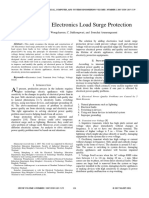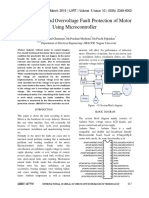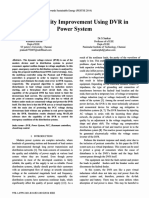Dosine Publication
Dosine Publication
Uploaded by
Demon GamerCopyright:
Available Formats
Dosine Publication
Dosine Publication
Uploaded by
Demon GamerOriginal Description:
Original Title
Copyright
Available Formats
Share this document
Did you find this document useful?
Is this content inappropriate?
Copyright:
Available Formats
Dosine Publication
Dosine Publication
Uploaded by
Demon GamerCopyright:
Available Formats
See discussions, stats, and author profiles for this publication at: https://www.researchgate.
net/publication/354283006
Development of a Low Cost Microcontroller Based Under and Over Voltage
Protection Device
Article in International Journal of Scientific Engineering and Technology · September 2014
CITATIONS READS
3 923
1 author:
Michael Oluwatosin Omojoyegbe
Samuel Adegboyega University
2 PUBLICATIONS 3 CITATIONS
SEE PROFILE
All content following this page was uploaded by Michael Oluwatosin Omojoyegbe on 01 September 2021.
The user has requested enhancement of the downloaded file.
International Journal of Scientific Engineering and Technology (ISSN : 2277-1581)
Volume No.3 Issue No.9, pp : 1225-1229 1 Sep 2014
Development of a Low Cost Microcontroller Based Under and Over Voltage
Protection Device
Ponnle A. A1, Omojoyegbe M. O.2
1
Department of Electrical and Electronics Engineering, Federal University of Technology, Akure, Nigeria
2
Works and Physical Planning Department, Samuel Adegboyega University, Ogwa, Nigeria
E-mail: ponnleakinlolu@yahoo.co.uk, meritolutosine@yahoo.com
Abstract— This paper presents the design and construction of caused by a number of occurrences such as supply system
a low cost under and over voltage protective device, which was faults, equipment failures, or malfunctions in control
fabricated using a microcontroller, transistor, IC and other equipment. Under-voltage might result into brownout,
discrete components. A microcontroller PIC16F877 is at the distortion or permanent damage while overvoltage in the form
heart of the device which performs the major control of the of spikes and surges could cause distortion, burn-out, melt-
device. The device is simple and of low cost. It can withstand down, fire, electro-pulsing and permanent damage.
loads up to 2KVA and the required set voltage range for the Owing to the incessant damages done by fluctuations in
device to allow supply to the connected load at the output the power supply, there is dire need to address the problem
varies from 200 – 240 Volts. It can be used to protect loads through other alternatives, which give birth to design and
such as refrigerator, T.V., VCR/DVD players etc. from construction of an equipment to protect the connected loads
undesirable over and under voltages, as well as surges caused against under and over voltage supply. Under and over
due to sudden failure/resumption of mains power supply. voltage protection is needed between supply terminal and the
This device can be used directly as a standalone equipment appliances (connected loads).
between the mains supply and the load, or it may be inserted
between an existing automatic/manual stabilizer and the load. II. Materials and Methods
The over/under voltage cut-off with time delay provides The main purpose of the device is to isolate the load from
over/under-voltage protection, and protection against over voltage and under voltage conditions by controlling the
transients. relay tripping coil using a PIC micro controller. The
Keywords— microcontroller, over voltage, under voltage, microcontroller will compare the supply voltage with the
protection. desired pre-set voltage and will operate the tripping coil in the
relay if the input voltage falls below or above the pre-set
I. Introduction range of values. The under voltage and the over voltage
Voltage irregularities are one of the greatest power quality protective device is shown in block diagram in Figure 1.
issues facing industry and home today and often times, is Input Voltage Set Voltage
responsible for damaging valuable electrical equipment. Monitor Input
Electrical Power System protection is required for protection of
Ac Input
PIC16F877A
both user and the system equipment from fault, hence electrical Power Regulator Liquid Crystal
Supply LM7805 Micro-controller Display Unit
appliances are not allowed to operate without any protective
device installed. Power System fault is defined as undesirable
condition that occurs in the power system, and the undesirable Relay Relay
Driver
conditions are short circuit, current leakage, ground short, over
current, under and over voltage. The ability of protection system
Load
is demanded not only for economic reason but for expert and
reliable service (Bayindar et al., 2008). Figure 1: Functional Block Diagram of the Under and Over
Technically speaking, an over/under voltage condition is Voltage Protective Device.
reached when the voltage exceeds/lags the nominal voltage by
10% for more than 1 minute. Short duration voltage events can A. Brief Explanation of Each Block
also occur such as transients (both impulsive and oscillatory), (1) AC Input: This is the input supply from the public utility
sags/dips and swells. Short duration intermittent supply failures where the device will be energized. It is also supplied directly
can last anywhere from 0.5 cycles up to 1 minute and can be
IJSET@2014 Page 1225
International Journal of Scientific Engineering and Technology (ISSN : 2277-1581)
Volume No.3 Issue No.9, pp : 1225-1229 1 Sep 2014
to the relay contacts in the device which connects the load to the
supply when the supply is within 200V – 240V range.
(2) Power Supply: The power supply uses a step down
transformer to step down the input mains voltage to a voltage
level suitable for the electronics within the device. A centre Figure 2: The LCD used.
tapped transformer, with two diodes for full wave rectification 6) Relay Driver: This is an NPN transistor that controls and
is used to convert the ac voltage to a pulsating dc voltage supplies current through the coil of the relay that connects the
followed by a filter, comprising of a capacitor to filter out mains supply to the load. The relay is a single pole relay
(smooth) the pulsation (Close and Yarwood, 1979; Maddock which, upon being activated by the PIC via the transistor,
and Calcuta, 1994; Ian, 2000). makes under normal mains supply voltage and brakes under
After the rectification and smoothening, a sample of the output abnormal mains supply voltage.
voltage is fed to the microcontroller through a potentiometer.
This voltage is unregulated and therefore varies as the input B. Relay Driver Design Analysis
mains voltage varies. The output voltage is also passed to an The relay driver circuit is shown in Figure 3. The relay
LM7805 positive voltage regulator to provide a regulated +5V driver uses NPN transistor BC547.
supply for the micro-controller. The regulator served to reduce
further the ripple and noise in the regulated supply to the
microcontroller. The regulator also provides current limiting
and protects the power supply and attached circuit from over
current (Paul and Winfield, 1989; Delton, 1989). Since the
system is to prevent against over and under voltage, the
transformer was designed and the windings were so selected for
the device to be able to sense and withstand input mains voltage
up to 600Vac.
Figure 3: The Relay Driver Circuit.
(3) PIC 16F877A Micro-Controller: The PIC16F877A
microcontroller, performs the major functions of decision and
The relay coil is connected between the positive rail and the
control. The input voltage monitor is connected to the micro-
collector of the transistor. When the input signal passes
controller which provides a sample of the input supply voltage
through the resistor R1 to the base of the transistor Q1, it
to the microcontroller for comparison with the programmed set
conducts and activates the relay RL1. Since a relay coil is not
values in the microcontroller. The PIC16F877A microcontroller
only an electromagnet but also an inductor (Gurevich and
was used in the design in order to reduce the complexity of the
Vladimir, 2005), a flyback diode D1 in parallel with a resistor
design and to ensure an easy interface with a liquid crystal
is used to eliminate fly back, which is the sudden voltage
display.
spike seen across an inductive load when its supply voltage is
suddenly reduced or removed. The diode also clamps the
(4) Input Voltage Monitor: This provides a sample of the
voltage across the coil to about 0.7V protecting the transistor
unregulated dc supply voltage through a potentiometer to feed
and other associated components. The stored energy
the microcontroller. It helps the microcontroller to monitor the
dissipates quickly in the diode and the resistor. The diode
supply voltage, as the value of this voltage varies as the input
used is IN4007.
mains voltage varies. The unregulated dc supply voltage is
DC current gain of the transistor, β is expressed as
scaled down by the potentiometer to values suitable for the
(Maddock and Calcuta, 1994),
micro-controller. Input mains voltage up to 600Vac can be
IC
monitored.
IB
(5) Liquid Crystal Display (LCD): This displays the supply (1)
voltage as well as some information at „switch on‟ or when the where IC is the collector current (through the relay coil), and
supply voltage is out of range of the desired pre-set range of IB is the base current.
values. The LCD used is LM016L having a 2 x 16 display. The
picture of the LCD is shown in Figure 2.
IJSET@2014 Page 1226
International Journal of Scientific Engineering and Technology (ISSN : 2277-1581)
Volume No.3 Issue No.9, pp : 1225-1229 1 Sep 2014
To calculate the value of the base resistor, the following were of components. The calibration is to set the potentiometer for
considered: threshold tripping of the relay in accordance to the pre-set
VIN = 5V (from microcontroller), and the relay that is used has a values in the microcontroller.
coil resistance of 120Ω. To protect the load from switching surges as well as from
Therefore, the relay coil current = collector saturating current = quick changeover (off and on) effect of over/under-voltage
ICSAT = 12V/120Ω = 100mA. relay, in case the mains voltage starts fluctuating in the
Assuming β = 100 (for BC547), vicinity of under or over voltage pre-set points, an „on-time‟
I CSAT delay was programmed in the microcontroller. When the
IB
mains supply goes out of pre-set (over or under voltage)
limits, the relay/load is turned off immediately and it is turned
(2)
„on‟ only when A.C. mains voltage settles within the pre-set
IB = 100/100 =1mA. limits for a period equal to the on-time delay period. The on-
The actual base current flowing, IBSAT must be higher than time delay period was made programmable for 500
the calculated base current IB to ensure base saturation. The milliseconds to 20 seconds duration. In the device,
base resistor, R1 must be able to provide this saturating base programmed on-time delay of 1 second was found
current.
satisfactory.
Using a 1KΩ resistor would ensure that the transistor is fully
“ON” when current passes out from the micro-controller 5V
source, i.e.
Vo VBE
I BSAT (3)
R1
= (5 – 0.7)/1x103
= 4.3mA which is >1mA.
C. Explanation of the Circuit Diagram
The circuit diagram of the developed device is shown in
Figure 4. The circuit was designed, and its functionality was
simulated using Proteus Software. The input mains supply is
stepped down by the centre tapped transformer TR1 to 12Vac at
input mains voltage of 220Vac. TR1 with diodes D1 and D3
provide centre tapped full wave rectification, which is
smoothened by capacitor C3. The unregulated dc output is fed to
the positive fixed voltage regulator U1 (LM7805) with regulated
output voltage of +5V.
The PIC monitors the input voltage through a potentiometer
RV3 and toggle switch SW1; set the input voltage range (as
presented by RV3) at which the relay will be energized; and
activates the liquid crystal display LCD1 which displays the
input mains voltage level and other information as the case may Figure 4: Circuit Diagram of the Microcontroller Based
be. The microcontroller sends signal to the relay driver Q 1 and Under and Over Voltage Protective Device.
thus energize the relay RL1 thereby connecting the mains supply
to the load. LED D4 indicates when there is mains supply to the
load. LED D4 used is a high current and high reverse voltage
III. Construction and Testing
LED. Diode D5 helps to provide a dc current through the LED
A. Construction
while resistor R2 limits the current to a safe value for the LED.
The design and the programming was simulated several
Diode D5 used is 1N4007.
times on Proteus software until the code for the design
Switch SW1 was incorporated to allow for manual test and
worked satisfactorily before the final programming of the
calibration of the device. The manual test is to ascertain the
microcontroller and assembly of the components (Martin,
functionality of the microcontroller after assembly and coupling
2008). The microcontroller is shown in Figure 5(a); the type
IJSET@2014 Page 1227
International Journal of Scientific Engineering and Technology (ISSN : 2277-1581)
Volume No.3 Issue No.9, pp : 1225-1229 1 Sep 2014
of programmer used for the microcontroller is a USB
programmer shown in Figure 5(b), and the programming code 14.5cm LCD Display
used is compiler CCS. The programming of the microcontroller Switch
LCD Display
was done by first writing the program code in C#, after which it Potentiometer LED Switch
Potentiometer Toggle
was compiled using the CCS compiler; then later the hex file LED Switch
was burned to the PIC through the USB programmer.
5.1cm
16.8cm Input
Mains
Supply Load
Terminals Terminals
Terminals for Input Terminals for
(a) Mains Supply connection To Load
(a) (b)
Figure 7: (a) Casing dimensions. (b) Completed device.
B. Testing
(b) There are two types of test carried out on the developed
device, they are Manual Test and Calibration.
Figure 5: (a) The PIC16F877A microcontroller, (b) The USB 1) Manual Test
programmer that was used. During the process of carrying out this test, the toggle
switch was put on the „Manual‟ test position. Then, the
The circuit was first bread boarded for effective
voltage protection device was turned ON, and it initially
manipulation of the design, and was tested to ascertain
displayed “Please wait” on the LCD unit, before the pre-set
satisfactory operation. The device was tested based on each
input voltage (200-240 volts) was finally displayed. The
stages of the design. The components were then assembled and
potentiometer was varied until mains voltage is supplied to
soldered both on Vero board and PCB, and then placed in a
the load. The purpose of the manual test is to verify the
plastic casing. The complete and populated circuit boards were
functionality of the microcontroller.
assembled and coupled in the plastic casing together with
2) Calibration
accessories such as output and input terminals, potentiometer
With the switch in „Calibration‟ position, the
knobs, input power cable, toggle switch, liquid crystal display
potentiometer was adjusted to divide down the voltage being
and output triggering indicator green light. Figure 6 shows the
monitored by the microcontroller to a safe value. Also, as the
device under construction; Figure 7(a) shows the dimension of
input mains supply voltage is varied using a variac, the
the casing, and Figure 7(b) shows the completed device.
potentiometer was used to set the threshold for tripping of the
relay. Immediately the output set voltage is reached, the load
received mains supply without any problem.
The completed device was tested with 200W
incandescent bulbs and house appliances such as television,
DVD players, refridgerator, and single phase surface pump;
and the performance was satisfactory. The condition for
output triggering was stable after several testing. The output
set voltage of 200-240 volts was maintained throughout the
test period.
IV. Conclusion
The aim of designing and constructing a low cost micro –
controller based under and over voltage protective device was
achieved in this work. The device supplies power to the
connected load whenever the input supply is within the
required pre-set voltage, thereby protecting the output
Figure 6: The device under construction.
connected loads from un-necessary damages. The device is
IJSET@2014 Page 1228
International Journal of Scientific Engineering and Technology (ISSN : 2277-1581)
Volume No.3 Issue No.9, pp : 1225-1229 1 Sep 2014
found to be economical, easier to maintain and repair. The iv. Gurevich H., and Vladimir S. (2005) “Electrical
device cost about $50 to produce. Relays: Principles and Applications” CRC Press, London-
New York.
References v. Ian S. L. (2000) “Passive Components for Circuit
i. Bayindir R., Sefa I., Cola I., and Bektas A. (2008) Design”, Texas, USA, p. 170. ISBN 008051359X.
“Fault Detection and Load Protection Using Sensors”, IEEE vi. Maddock R. J. and Calcute P. (1994) “Electronics:
Transactions on Energy Conversion, Vol. 23, Issue 3, pp. 734– A Course for Engineers” 2nd Edition; Longman Essek,
741. London.
ii. Close K. J., and Yarwood J. (1979) “Experimental vii. Martin P. B. (2008) “Programming 8-Bit PIC
Electronics for Students” 1st Edition, Chapman and Hall Ltd, Microcontrollers in C with Interactive Hardware Simulation”
Britain. ISBN: 978-0-7506-8960-1.
iii. Delton T. H. (1989) “Basic Electronic Theory with viii. Paul H., and Winfield H. (1989) “The Art of
Projects and Experiment” 3rd Edition; TAB Book Inc. Blue Electronics”, Second Edition, Cambridge University Press,
Ridge Summit, P.A. Cambridge MA, p. 58, ISBN 0-521-37095-7.
IJSET@2014 Page 1229
View publication stats
You might also like
- Power Plant ProtectionDocument0 pagesPower Plant ProtectionSHIVAJI CHOUDHURY100% (8)
- Introduction to Power System ProtectionFrom EverandIntroduction to Power System ProtectionRating: 4 out of 5 stars4/5 (2)
- 1000 Leggyakoribb Orosz SzóDocument17 pages1000 Leggyakoribb Orosz Szószpista0% (1)
- Bode Diagrams of Transfer Functions and Impedances: ECEN 2260 Supplementary Notes R. W. EricksonDocument49 pagesBode Diagrams of Transfer Functions and Impedances: ECEN 2260 Supplementary Notes R. W. Ericksondivya k sNo ratings yet
- Simple Web-Hacking TechniquesDocument3 pagesSimple Web-Hacking Techniquesadrianshephard100% (1)
- Development of A Low Cost Microcontroller Based Under and Over Voltage Protection DeviceDocument5 pagesDevelopment of A Low Cost Microcontroller Based Under and Over Voltage Protection DeviceAbdul KutaNo ratings yet
- Implementation of Inverse Define Minimum Time Under and Over Voltage RelayDocument6 pagesImplementation of Inverse Define Minimum Time Under and Over Voltage RelayRika Elvan YulindaNo ratings yet
- Development of A Low Cost Under VoltageDocument9 pagesDevelopment of A Low Cost Under Voltagefiyoviw911No ratings yet
- Review PaperDocument4 pagesReview PaperModi HardikNo ratings yet
- Idosr JST 41 81 105 2019. PuDocument25 pagesIdosr JST 41 81 105 2019. Pujamiu1175No ratings yet
- High Low Voltage Protection Device SysteDocument6 pagesHigh Low Voltage Protection Device SysteHurshed HujamovNo ratings yet
- Voltage Sag and Mitigation Using Dynamic Voltage Restorer DVR System For Power Quality ImprovementDocument8 pagesVoltage Sag and Mitigation Using Dynamic Voltage Restorer DVR System For Power Quality ImprovementInternational Journal of Innovative Science and Research TechnologyNo ratings yet
- Project Proposal ReportDocument24 pagesProject Proposal ReportsachinchunilallNo ratings yet
- Design of AC Electronics Load Surge Protection: N. Mungkung, S. Wongcharoen, C. Sukkongwari, and Somchai ArunrungrasmiDocument6 pagesDesign of AC Electronics Load Surge Protection: N. Mungkung, S. Wongcharoen, C. Sukkongwari, and Somchai ArunrungrasmiMukbsNo ratings yet
- Unit 1Document70 pagesUnit 1Dilip Kumar100% (1)
- Arduino Based Transformer ProtectionDocument8 pagesArduino Based Transformer ProtectionAbdullah MdNo ratings yet
- Construction of An Extension Box With Surge Protection and Usb Port For CharingDocument38 pagesConstruction of An Extension Box With Surge Protection and Usb Port For CharingEsajumi MichaelNo ratings yet
- Improvement For Power Quality by Using Dynamic Voltage Restorer in Electrical Distribution NetworksDocument6 pagesImprovement For Power Quality by Using Dynamic Voltage Restorer in Electrical Distribution Networksaakanksha.adoniNo ratings yet
- Power Quality Enhancement Using Custom PDocument7 pagesPower Quality Enhancement Using Custom PppNo ratings yet
- Voltage Sag and Mitigation Using Dynamic Voltage Restorer (DVR) SystemDocument6 pagesVoltage Sag and Mitigation Using Dynamic Voltage Restorer (DVR) SystemUzhansEell-neinoNo ratings yet
- Electrical Power Transmission: Louiebert E. VirayDocument30 pagesElectrical Power Transmission: Louiebert E. VirayCyrill Roi Domangcas BausoNo ratings yet
- Meru University of Science and TechnologyDocument20 pagesMeru University of Science and Technologyedukip13No ratings yet
- Overvoltage, Undervoltage Protection of Electrical EquipmentDocument4 pagesOvervoltage, Undervoltage Protection of Electrical EquipmentKasahun GirmaNo ratings yet
- Op-Amp Based Static Over Current RelayDocument6 pagesOp-Amp Based Static Over Current RelayS Bharadwaj ReddyNo ratings yet
- Energy ManagementDocument55 pagesEnergy ManagementNjitnumNo ratings yet
- SPD Catalogue2014Document20 pagesSPD Catalogue2014William YeepNo ratings yet
- Arduino Base Over Voltage and Under Voltage Protection Circuit LITERATURE REVIEWDocument23 pagesArduino Base Over Voltage and Under Voltage Protection Circuit LITERATURE REVIEWOlasupo IyaboNo ratings yet
- 22-Article Text-158-1-10-20191204Document6 pages22-Article Text-158-1-10-20191204Syed UmerNo ratings yet
- BSB Circular Ride-Through Solutions For Voltage Dip Problems in BuildingsDocument21 pagesBSB Circular Ride-Through Solutions For Voltage Dip Problems in BuildingsYeung HofanNo ratings yet
- Chapter 2 Overvoltage UndervoltageDocument12 pagesChapter 2 Overvoltage UndervoltageCaliNo ratings yet
- Automation of Maximum Load Control Using 8051-MicrocontrollerDocument7 pagesAutomation of Maximum Load Control Using 8051-MicrocontrollerIOSRJEN : hard copy, certificates, Call for Papers 2013, publishing of journalNo ratings yet
- Research PaperDocument4 pagesResearch PaperMahesh ShendeNo ratings yet
- Voltage Characteristics 1Document6 pagesVoltage Characteristics 1solomon 12ableNo ratings yet
- Over Under Voltage and Over Current Protection SystemDocument8 pagesOver Under Voltage and Over Current Protection SystemHassan Ali100% (1)
- Chapter One-Wps OfficeDocument13 pagesChapter One-Wps OfficeBlessing IyalaghaNo ratings yet
- Over Current Protection Relay Using Pic Micro ControllerDocument25 pagesOver Current Protection Relay Using Pic Micro Controllersaranaccel1100% (2)
- Power Quality MitigationDocument7 pagesPower Quality MitigationSunil SinghNo ratings yet
- Power Transformer Protection Using Microcontroller-Based RelayDocument66 pagesPower Transformer Protection Using Microcontroller-Based Relaybisanikumarbabu100% (5)
- ThesisDocument20 pagesThesisczds6594No ratings yet
- Chapter 2 OvervoltageDocument11 pagesChapter 2 OvervoltageCaliNo ratings yet
- 3.3 Selection of Switchyard Equipment For SHPDocument99 pages3.3 Selection of Switchyard Equipment For SHPKrishna Mohan Sharma100% (1)
- Iaetsd-Minimization of Voltage Sags and Swells Using DVRDocument8 pagesIaetsd-Minimization of Voltage Sags and Swells Using DVRiaetsdiaetsdNo ratings yet
- Voltage Sag and Mitigation Using Dynamic Voltage Restorer (DVR) SystemDocument6 pagesVoltage Sag and Mitigation Using Dynamic Voltage Restorer (DVR) Systemreza hariansyahNo ratings yet
- Coren Write UpDocument20 pagesCoren Write UpBabatunde MartinsNo ratings yet
- Ijirt147770 Paper PDFDocument2 pagesIjirt147770 Paper PDFSHRINGERI ACADEMYNo ratings yet
- Design and Implementation of An Automatic High-Performance Voltage StabilizerDocument10 pagesDesign and Implementation of An Automatic High-Performance Voltage StabilizerMarcel DessapNo ratings yet
- Design and Implementation of An Automatic High-Performance Voltage StabilizerDocument11 pagesDesign and Implementation of An Automatic High-Performance Voltage StabilizerRANAIVOARILALA FanomezantsoaNo ratings yet
- Power Quality Improvement Using DVRDocument6 pagesPower Quality Improvement Using DVRNirav RanaNo ratings yet
- Ultrafast Electronic Cricuit Breaker PDFDocument2 pagesUltrafast Electronic Cricuit Breaker PDFarjun royalNo ratings yet
- 246 AndradaDocument5 pages246 AndradaMOHAMMAD MAZNo ratings yet
- 2UCD120000E002 - H PCS100 UPS-I Technical CatalogueDocument56 pages2UCD120000E002 - H PCS100 UPS-I Technical CatalogueGeorgeNo ratings yet
- PDF To WordDocument13 pagesPDF To WordAjay Kumar0% (1)
- E11 Unified Requirements For Systems With Voltages Above 1 KV Up To 15 KV E11Document7 pagesE11 Unified Requirements For Systems With Voltages Above 1 KV Up To 15 KV E11beho2000No ratings yet
- Dhaval VDRDocument57 pagesDhaval VDRPriyanth AcharyaNo ratings yet
- Intelligent Monitoring of Ups System: Under The Guidance ofDocument40 pagesIntelligent Monitoring of Ups System: Under The Guidance ofTushar MenonNo ratings yet
- Electrical Safety in LV InstallationsDocument12 pagesElectrical Safety in LV InstallationsmonvirtuosoNo ratings yet
- Project Report Name-Shahil Kumar Singh REG NO - 19110126051 Roll No - 19eee43 Branch - Eee College - Bce BakhtiyarpurDocument20 pagesProject Report Name-Shahil Kumar Singh REG NO - 19110126051 Roll No - 19eee43 Branch - Eee College - Bce BakhtiyarpurShahilsingh SinghNo ratings yet
- Over Under Voltage ProtectionDocument49 pagesOver Under Voltage ProtectionChandra Shekhar100% (1)
- Chapter 1Document4 pagesChapter 1Anonymous nWe63sA25No ratings yet
- Analog Dialogue Volume 46, Number 1: Analog Dialogue, #5From EverandAnalog Dialogue Volume 46, Number 1: Analog Dialogue, #5Rating: 5 out of 5 stars5/5 (1)
- Protection of Substation Critical Equipment Against Intentional Electromagnetic ThreatsFrom EverandProtection of Substation Critical Equipment Against Intentional Electromagnetic ThreatsNo ratings yet
- Hasthi HoonDocument4 pagesHasthi HoonDemon GamerNo ratings yet
- DFGDFJHKDocument18 pagesDFGDFJHKDemon GamerNo ratings yet
- Smart Irrigation Based On Crops Using IoTDocument6 pagesSmart Irrigation Based On Crops Using IoTDemon GamerNo ratings yet
- Low Otsmart IrrigationDocument5 pagesLow Otsmart IrrigationDemon GamerNo ratings yet
- Literature Study On Bus TreminalDocument3 pagesLiterature Study On Bus TreminalVenkat100% (3)
- LME Trading Calendar 2018 2028Document2 pagesLME Trading Calendar 2018 2028Rasmi RanjanNo ratings yet
- Bentocryl 86Document1 pageBentocryl 86mevice63No ratings yet
- Environmental Awareness L1Document27 pagesEnvironmental Awareness L1Rose Belle A. GarciaNo ratings yet
- The Performance Paradox in The Public SectorDocument15 pagesThe Performance Paradox in The Public Sectorrestu anindityaNo ratings yet
- CHED-NCR StuFAP On-Line ApplicationDocument1 pageCHED-NCR StuFAP On-Line Applicationnfalkdrf alkfalkNo ratings yet
- Zeeshan LiaqatDocument1 pageZeeshan Liaqatgourav GuptaNo ratings yet
- Load-Bearing Tilt-Up Concrete Wall PanelsDocument149 pagesLoad-Bearing Tilt-Up Concrete Wall PanelsxufafruitjuiceNo ratings yet
- NATA - User Checks & Maintenance of Lab BalancesDocument8 pagesNATA - User Checks & Maintenance of Lab BalancesEstiNo ratings yet
- Cost of Co2 Transport and StorageDocument76 pagesCost of Co2 Transport and StoragepxkmqoemsebyzugqqdNo ratings yet
- FISH-ISCN 1 (Genetics)Document18 pagesFISH-ISCN 1 (Genetics)zohrakiran7No ratings yet
- Lunt - Financial System of The Mediaeval PapacyDocument46 pagesLunt - Financial System of The Mediaeval PapacyTodika RaulNo ratings yet
- Pregnancy at Risk Preexisting ConditionsDocument39 pagesPregnancy at Risk Preexisting ConditionsMatthew RyanNo ratings yet
- Cylindrical Shell Type StructureDocument12 pagesCylindrical Shell Type StructureSneha NairNo ratings yet
- AIRCONDITIONINGDocument13 pagesAIRCONDITIONINGrini0026No ratings yet
- QuestionnaireDocument2 pagesQuestionnaireElena moralesNo ratings yet
- Dashavtar: Traditional Folk Theatre FormDocument4 pagesDashavtar: Traditional Folk Theatre FormJoe michael Roshan100% (1)
- DEll PMSDocument64 pagesDEll PMSDipak ThakurNo ratings yet
- sr3c Safety Emergency Stop RelayDocument6 pagessr3c Safety Emergency Stop Relayalexzander589No ratings yet
- NOTA Large Angle Stability 2009Document6 pagesNOTA Large Angle Stability 2009Abdul HadiNo ratings yet
- Sirona ProFeel+ Dental Unit Cleaning PlanDocument1 pageSirona ProFeel+ Dental Unit Cleaning PlanRoberto FalconeNo ratings yet
- Unit - 2 Lean ManagementDocument34 pagesUnit - 2 Lean ManagementGorantla Kalicharan100% (1)
- ENGLISHDocument9 pagesENGLISHsrikantameleka40No ratings yet
- Box Turtle Diet in Keys - Steven G. Platt, Clint Hall, Hong Liu and Christopher K. BorgDocument13 pagesBox Turtle Diet in Keys - Steven G. Platt, Clint Hall, Hong Liu and Christopher K. BorgAdrianNo ratings yet
- CH Student List 2017 18Document8 pagesCH Student List 2017 18Pushpendra VermaNo ratings yet
- L1-V4-04-MiCOM C264 HMI-E-01Document35 pagesL1-V4-04-MiCOM C264 HMI-E-01Rinda_Rayna100% (1)
- Y10 05 P30 Assessment v2Document7 pagesY10 05 P30 Assessment v2ayten.sherifNo ratings yet





























































































